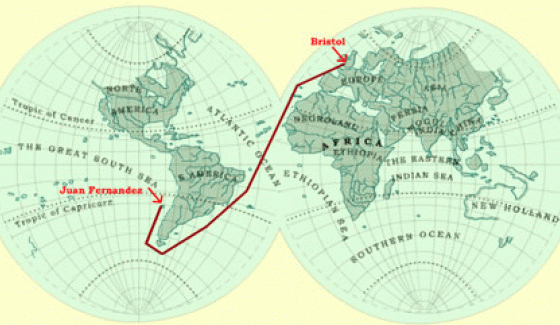The real Robinson Crusoe: Alexander Selkirk on Gunpowder Island explored
 |
Credit: iStockphoto/Duncan Walker
A scene from Robinson Crusoe, showing Crusoe and Friday. |
So when I later learned that the Crusoe character may have been based on the real-life Alexander Selkirk, it wasn't all that surprising. For any writer of fiction, creating a character and the world they live in is a lot of work. Research, mostly. How much easier and more likely to ring true with readers is to take a real-life character, world and situation to work with. Been done so many times.
This bit of research from 2008 examines the island on which Selkirk lived, an island now known as Robinson Crusoe's. Earth-shattering? Nah. Interesting? Yes.
Here's the report with a link to the full report in the attribution.
* * * * *
Real Robinson Crusoe:
Evidence Of Alexander Selkirk’s Desert Island Campsite
An archaeological dig unearths evidence of the campsite of castaway Alexander Selkirk, the model for Robinson Crusoe. Cast away on a desert island, surviving on what nature alone can provide, praying for rescue but fearing the sight of a boat on the horizon. These are the imaginative creations of Daniel Defoe in his famous novel Robinson Crusoe. Yet the story is believed to be based on the real-life experience of sailor Alexander Selkirk, marooned in 1704 on a small tropical island in the Pacific for more than four years, and now archaeological evidence has been found to support contemporary records of his existence on the island.

An article in the journal Post-Medieval Archaeology presents evidence from an archaeological dig on the island of Aguas Buenas, since renamed Robinson Crusoe Island, which reveals evidence of the campsite of an early European occupant. The most compelling evidence is the discovery of a pair of navigational dividers which could only have belonged to a ship’s master or navigator, as evidence suggests Selkirk must have been. Indeed Selkirk’s rescuer, Captain Woodes Rogers’ account of what he saw on arrival at Aguas Buenas in 1709 lists ‘some practical pieces’ and mathematical instruments amongst the few possessions that Selkirk had taken with him from the ship.

The finds also provide an insight into exactly how Selkirk might have lived on the island. Postholes suggest he built two shelters near to a freshwater stream, and had access to a viewpoint over the harbour from where he would be able to watch for approaching ships and ascertain whether they were friend or foe. Accounts written shortly after his rescue describe him shooting goats with a gun rescued from the ship, and eventually learning to outrun them, eating their meat and using their skins as clothing. He also passed time reading the Bible and singing psalms, and seems to have enjoyed a more peaceful and devout existence than at any other time in his life.
David H Caldwell, National Museums Scotland, is pleased with the results of the dig: “The evidence uncovered at Aguas Buenas corroborates the stories of Alexander Selkirk’s stay on the island and provides a fascinating insight into his existence there. We hope that Aguas Buenas, with careful management, may be a site enjoyed by the increasing number of tourists searching for the inspiration behind Defoe’s masterpiece.”
Alexander Selkirk was born in the small seaside town of Lower Largo, Fife, Scotland in 1676. A younger son of a shoemaker, he was drawn to a life at sea from an early age. In 1704, during a privateering voyage on the Cinque Ports, Selkirk fell out with the commander over the boat’s seaworthiness and he decided to remain behind on Robinson Crusoe Island where they had landed to overhaul the worm-infested vessel. He cannot have known that it would be five years before he was picked up by an English ship visiting the island.
Published in 1719, Robinson Crusoe is one of the oldest and most famous adventure stories in English literature. Whilst it is unclear whether Defoe and Selkirk actually met, Defoe would certainly have heard the stories of Selkirk’s adventure and used the tales as the basis for his novel.
Related stories:
- 500,000 year old engraving discovered
- Ayla and Jondular had blue eyes, but were black
- Bad News: We're Not So Different From Earliest Humans
- Did Life Arise Spontaneously? New Study Clarifies the Answer.
- Did a Volcanic Eruption Kill Off the Neandertals? Science Determines: Sorta
- Did Neandertal evolve all at once? Or slowly over time?
- DNA Research Shows a Mystery Population Invented Agriculture
- Early human ancestors used their hands like modern humans
- Fighting shaped human hands
- Genetic Diversity Linked to Today's Taller, Smarter People
- Here, kitty, kitty, kitty. Humans met sabre-tooth cats 300,000 years ago
- How Humans Got Hips
- How Our Stone Age Ancestors Lived & Hid
- Humans and apes share personality traits. Which can explain a lot.
- The Killing Advantage of Stone Tipped Spears
- Lowered testosterone allowed culture & technology to blossom
- Neandertal ritual or Neandertal cannibalism?
- Neanderthals were good parents
- New Stone Age Evidence of Cannibalism
- The Quest for Fire, Revisited
- The Small But Important Difference Between Apes and Humans
- Were our ancestors stoners? Could be. Or not.
- White skin is not about making vitamin D. It's about preventing dehydration.
Comments
Post a Comment